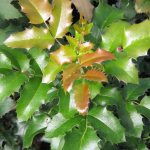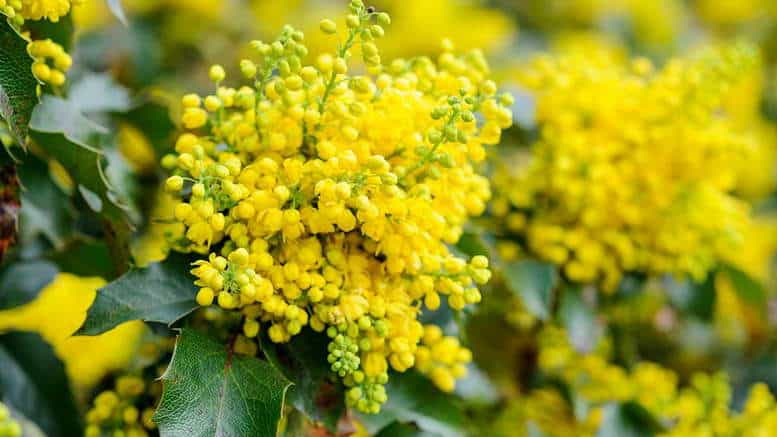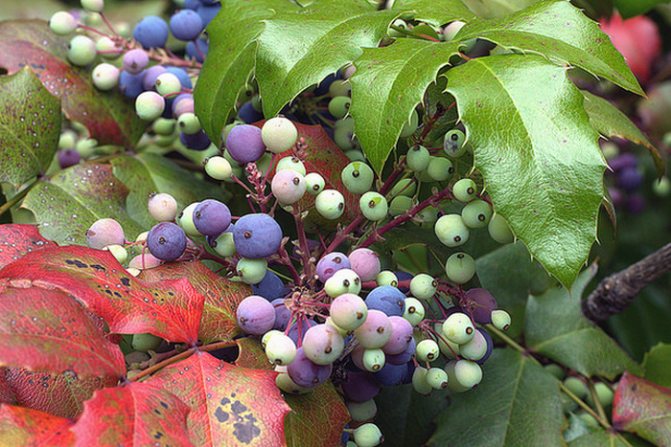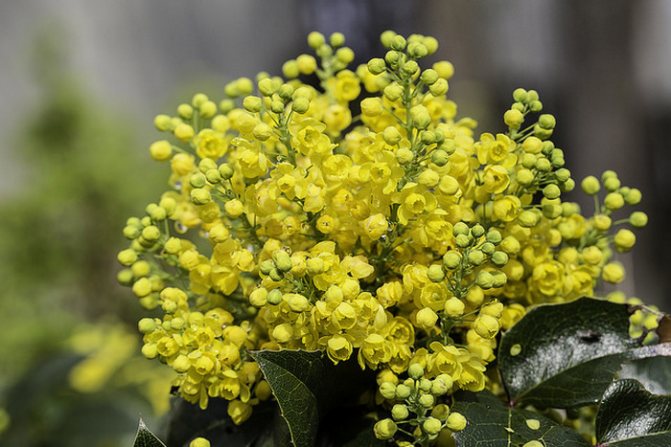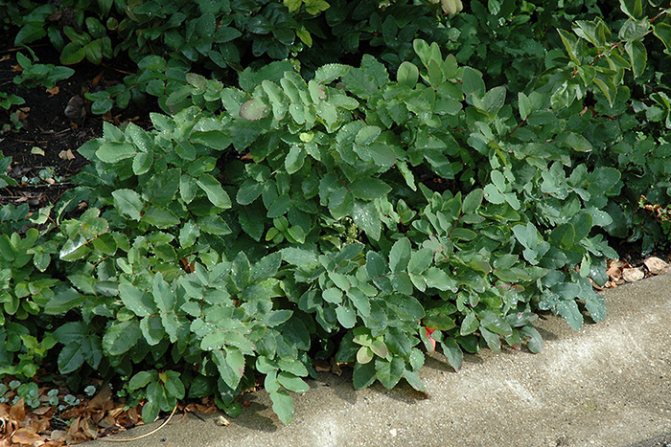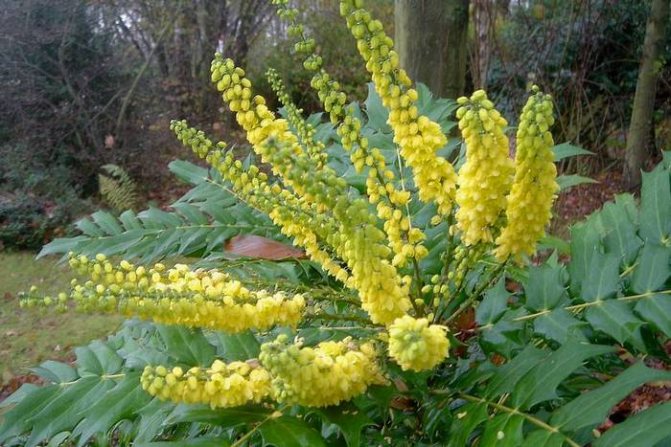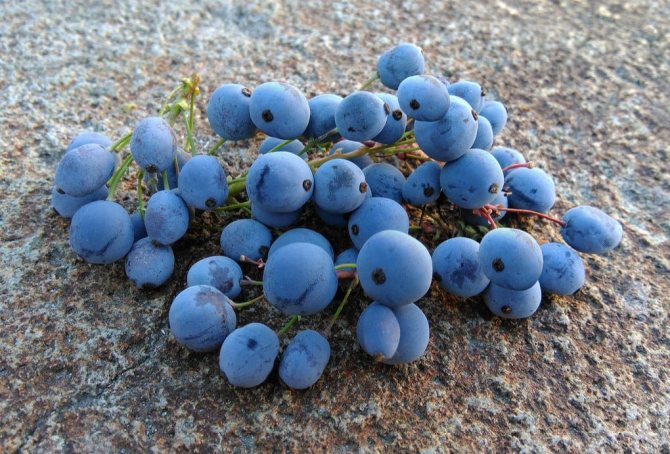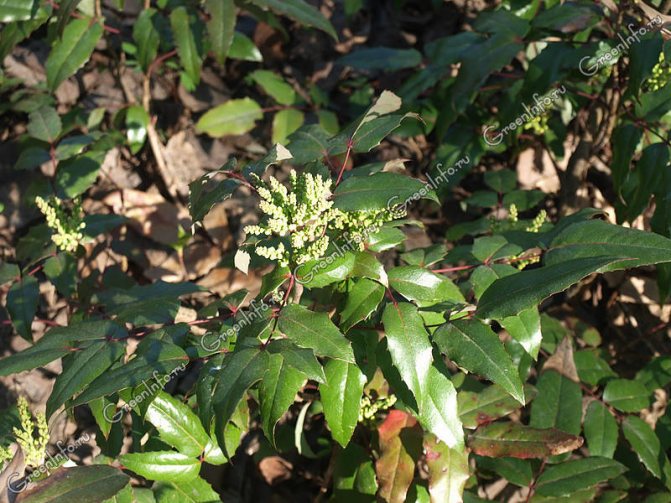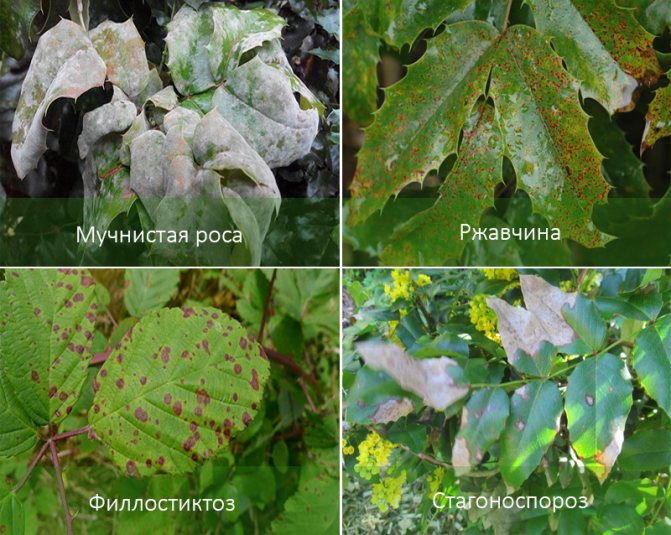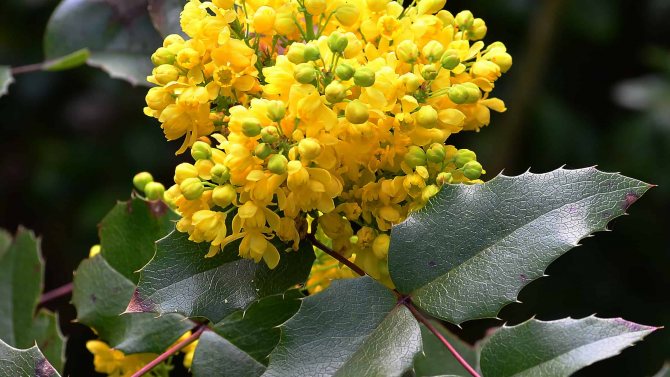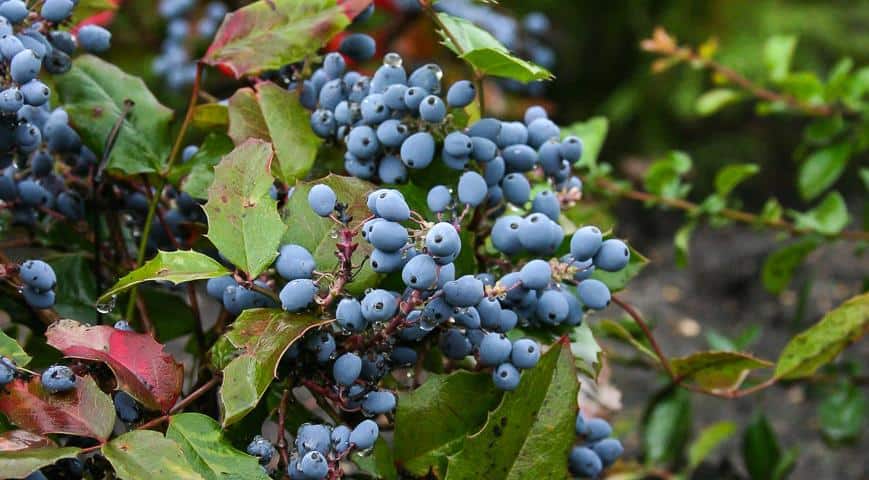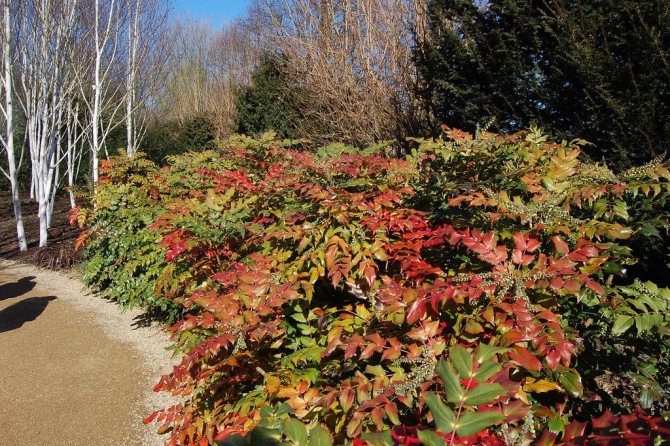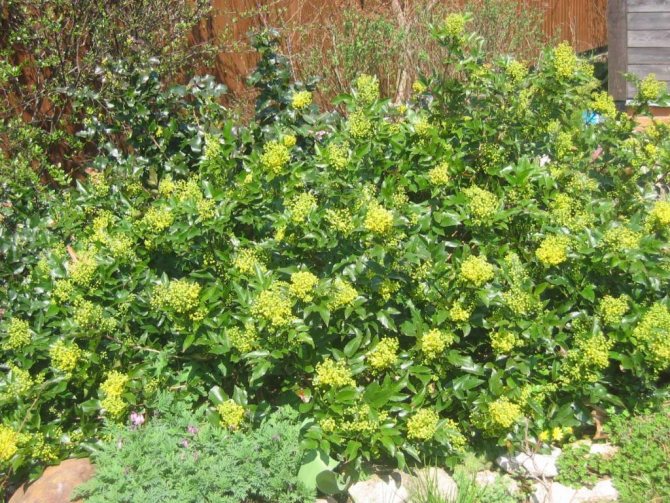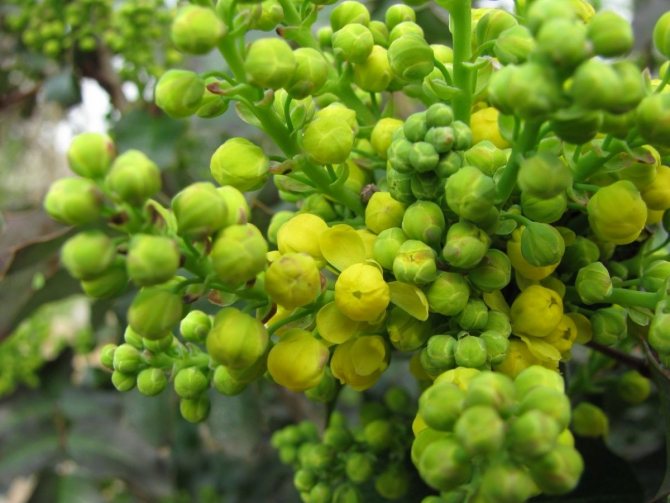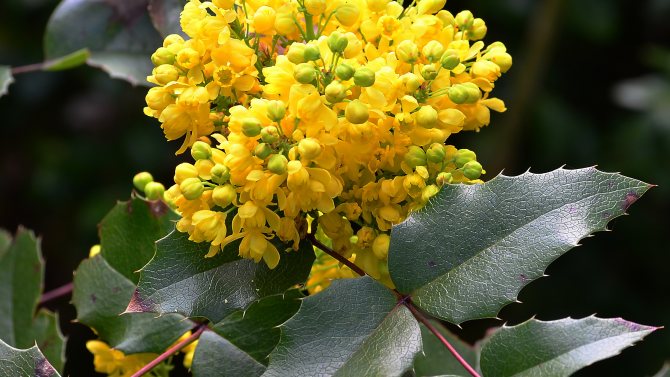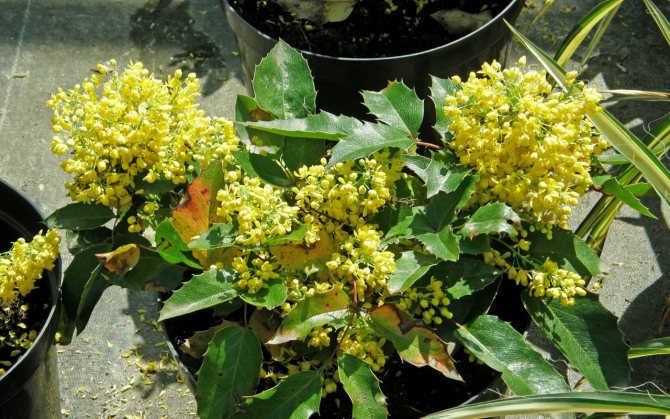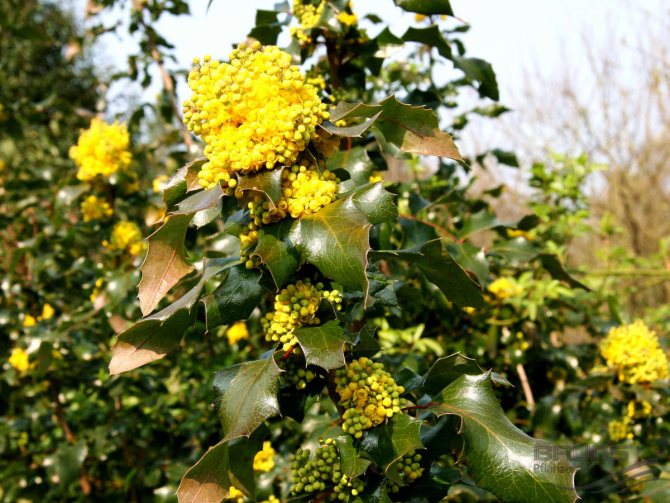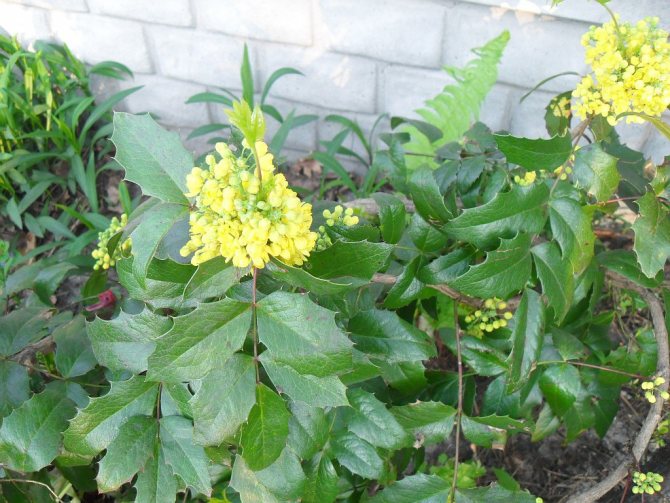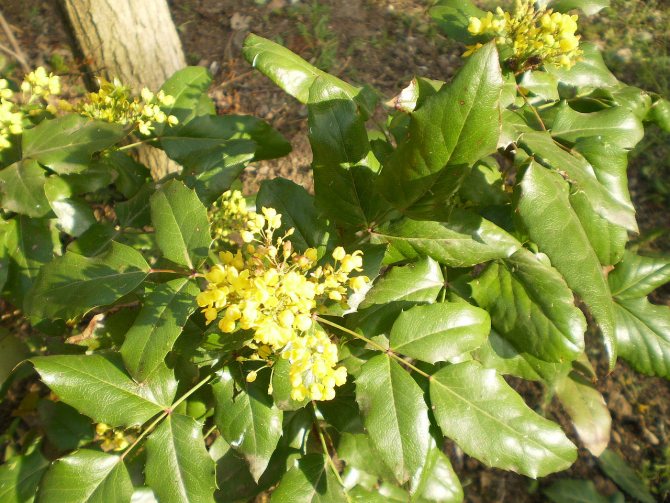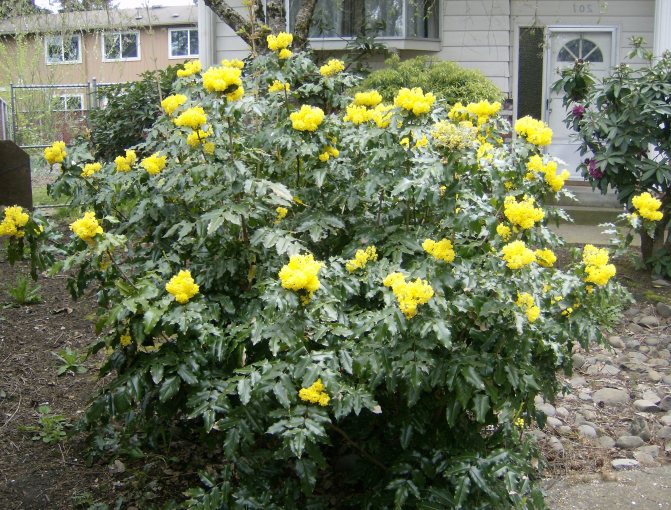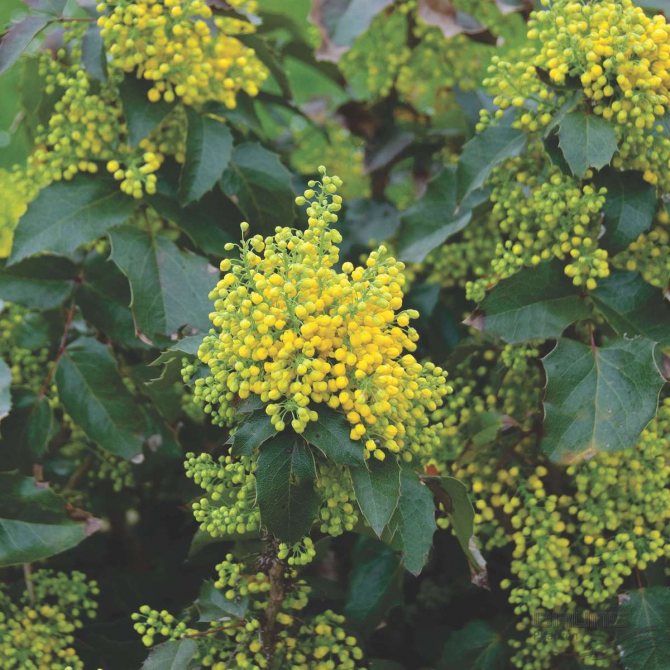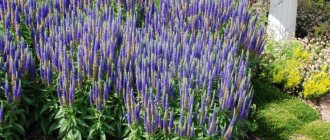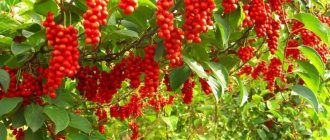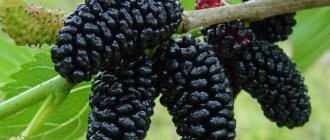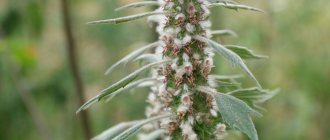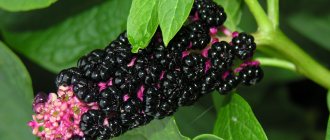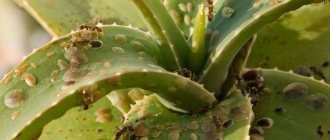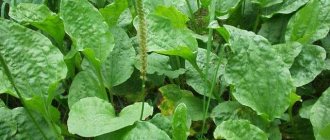Mahonia holly is an evergreen shrub that has recently been actively used to create a hedge with high decorative qualities. In addition, fruits in the form of berries are formed on this plant, which can be used for food. This plant is also used as a medicine.
Mahonia holly is an evergreen shrub that has recently been actively used to create a hedge with high decorative qualities.
Species characteristics
Mahonia aquifolium is a species that belongs to the Barberry family and the genus Mahonia.
Under natural conditions, this plant grows in western North America, from California to British Columbia.
The characteristic of the species is as follows:
- The height of the shrub reaches an average of 1 m. It has the ability to quickly grow in different directions due to root suckers. It is this property that allows the plant to be used as a hedge.
- On young shoots, the bark is pinkish. Mature shoots acquire longitudinal stripes, and the bark itself is painted in gray-brown shades.
- Leaves are compound, have up to 9 composite leaves. The total length of the entire leaf is on average 17 cm, the petioles are painted in reddish shades. The leaves are adapted to arid conditions - they are covered with a leathery cover, dark green above, with gloss, matte, light green below. The veins are pressed into the plastic sheet.
- Each flower is only 8 mm in diameter. However, they are all collected in inflorescences - panicles or brushes. The flowers are bright, light yellow with a shade of lemon.
- After flowering, berries are formed. They have an oblong-elliptical shape and average dimensions: up to 10 mm in length, up to 8 mm in width. The color of ripe fruits is dark blue with a bluish bloom and fluff. Plaque and fluff are also adaptations for survival in arid conditions. The berries have a sweet and sour taste. For these fruits, collected in a bunch resembling grape, this plant was named the Oregon grape.
The main pests and diseases of the plant
In general, Mahonia has established itself as a very resistant plant to all sorts of pests and diseases. However, it can also be comprehended by various ailments: spotting, rust, powdery mildew.
Therefore, preventive spraying plays an important role in plant care.
So, you can protect the shrub from spotting by treating it with copper-containing preparations.

It can be, for example, a mixture of copper sulfate (20 g) and green soap (180-200 g), diluted in water (10 l), or Bordeaux liquid.
For powdery mildew (white bloom on the upper and lower sides of leaves and petioles), gardeners recommend spraying with Fundazol, Callatan or colloidal sulfur (2 times a month).
Sulfur-containing preparations help to defeat rust, as well as the spring treatment of the crown with the "Tsineb" preparation. At the first detection of red spots on the leaves, they must be removed.. In this way, further infection can be avoided.
Demanding environmental conditions
Mahonia is holly - a somewhat paradoxical plant. Despite its origin from regions with mild climates, it tolerates our freezing winters well.This does not mean that it can be used in all regions of vast Russia, but nevertheless, holly mahonia can withstand frosts down to -30 ° C.
What are wild strawberries?
However, this overseas plant does not tolerate the alternation of frost and thaw, as well as strong winds at low temperatures. In regions with harsh winters, where severe frosts are accompanied by winds and a small layer of snow, partial or complete cover of the bushes is desirable.
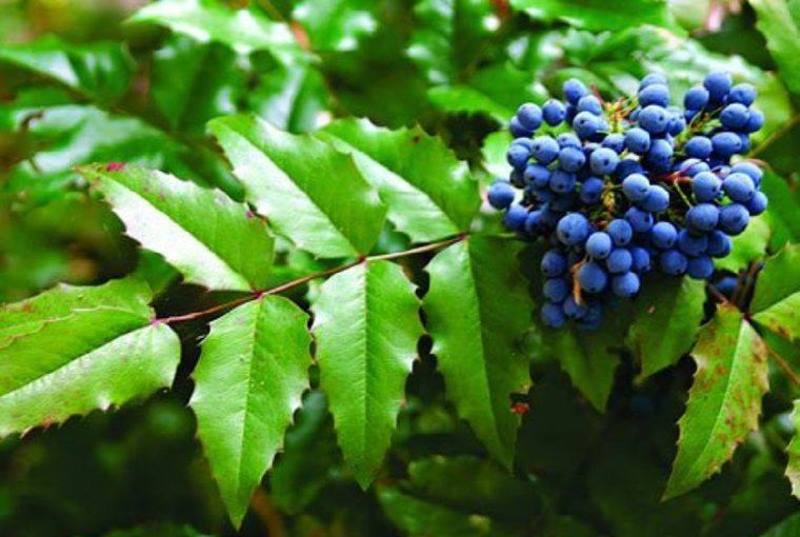

Mahonia aquifolium is a species that belongs to the Barberry family and the genus Mahonia
In the temperate zone, adult Mahonia bushes usually do not cover. Young bushes have to be covered with dry grass, spruce branches, synthetic materials. In very harsh conditions, adult plants are also sheltered. At least the root part of the plant needs it.
In regions with long summers and short warm winters, Mahonia can bloom a second time, delighting people with flowers at the end of September or even in October. If the weather permits, this bloom can last for several months. Moreover, by May, winter berries are already ripening, which soon give way to new flowers. In the conditions of Russia, this is possible in the Crimea and the Caucasus.
For this plant to thrive and produce berries, it needs to provide nutrient-rich, light soil. In this case, the acidity should be neutral or, in extreme cases, slightly acidic.
Mahonia's love for light soil requires a person to dig the earth before planting seedlings. If the soil is heavy, then you will still have to prepare a special drainage pit. Its dimensions should be larger than those required for a normal planting. At the bottom of such a pit, drainage from crushed stone or large pebbles is laid. On top of the drainage layer, it is advisable to lay first a layer of manure or humus, then a small layer of sand. From above, all this is laid with sod soil and a layer of dry leaves. Only then can the bush root be immersed in the ground.


In regions with long summers and short warm winters, Mahonia can bloom a second time, delighting people with flowers at the end of September or even in October.
How to choose a place and prepare the soil for planting Mahonia holly


Despite the fact that Mahonia does not require special conditions in terms of the type and composition of the soil, nevertheless, it feels best in fresh, loose, slightly acidic soil with good drainage, rich in humus and good moisture retention.
The favorite soil mixture of Mahonia is humus, turf soil, sand in a ratio of 2: 2: 1.
The plant does not like stagnant water and alkaline soils.
There are only two problems that you will need to solve before you start planting a bush: the plant does not tolerate constant winds and direct sunlight.
Important! Mahonia holly must be planted in calm and slightly shaded areas.
A huge advantage of the shrub is that it is resistant to pollution by exhaust gases, so it can be safely planted in city squares and parks, near busy highways and even in industrial zones.
Placing magonia on the site
In order to properly plant Mahonia seedlings, it is imperative to start the whole process in early spring. In each region, this period is determined in its own way, but the main criterion is the complete thawing of the soil and the appearance of the first green grass growing in the wild.
The use of common chicory
This plant is transplanted by the root. The larger clod of earth is transferred with it to a new place, the better - the plant will hurt less, grow faster and bloom.
If you transplant the bush yourself, then with a large coma of earth, there will be no special problems. However, when planting purchased material, the prognosis of plant survival is not always favorable.
The transfer begins with the choice of a landing site.The exactingness of Mahonia to environmental conditions limits the gardener in choosing a suitable site. Good lighting and wind protection are required. It is possible to choose a lighted place for the functions of a hedge, but fences are not always placed where there is no wind.
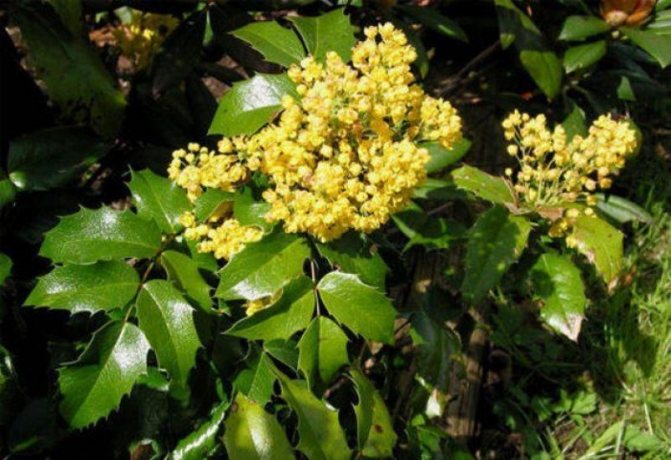

Demanding soil fertility can always be compensated by the formation of a planting trench and subsequent top dressing. But it is unlikely that it will be possible to compensate for low illumination - your bushes will be elongated and thin. It will be difficult to make a fence from such plants.
For plantings of a single type, it is necessary to observe a distance between specimens of 2 m.If a hedge is planted, then the distance between specimens must be reduced to 1 m.
The optimum planting depth is 40-50 cm. At the same time, it is impossible to drop in the root collar - it should be at the level of the soil surface.
One more circumstance should be taken into account. In order for Mahonia to not only bloom, but also bear fruit, it is necessary that there are other specimens of this plant nearby. Only in this case will insects be able to transfer pollen, which will contribute to the harvest.
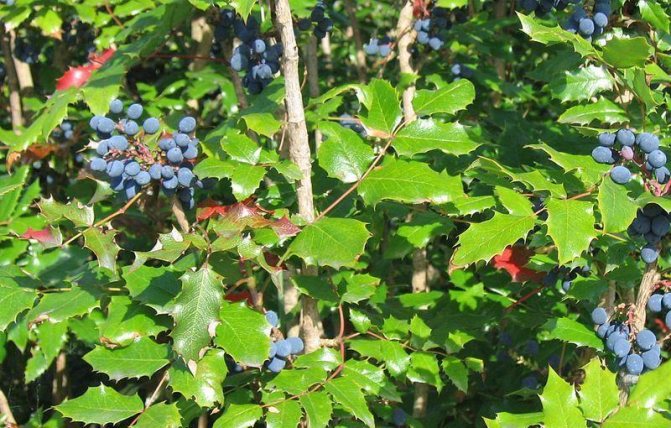

What did Mahonia like to gardeners?
A photo of a plant can already arouse interest. Therefore, a rare gardener remains indifferent to the beauty of the leathery leaves of Mahonia, which it retains unchanged throughout almost the entire growing season. Seeing for the first time its leaves, their can be mistaken for holly leaves, which, in principle, explains the name of the plant. In the spring, when the leaves begin to bloom, they are reddish in color. However, in the summer it changes to dark green, and in the fall, when the growing season comes to an end, they acquire a golden-bronze hue.
Even more beautiful stems of Mahonia become at the moment of the onset of the first frosts, which change its color to purple.
Such a variety of color palette is one of the reasons for the increased interest of many gardeners in this plant, which is often used in landscape design. Therefore, when decorating their sites, they often choose Mahonia. The plant fits perfectly into the design of the rock garden, and can also be presented as part of various group compositions, including lawn areas. With the help of Mahonia, you can ennoble various buildings if you plant it next to them. It also allows you to emphasize the greenery of the gardens. Since Mahonia is a short plant, it can be successfully used as a curb plant or a low hedge.
In the process of development, Mahonia holly appears a lot outgoing root suckers, therefore, during the season, it can form small thickets. In this regard, Mahonia seems to be an excellent option for decorating those areas where it is necessary to fill the soil surface.
How to care for Mahonia
This plant is considered unpretentious, but it still needs some care. It consists of the following activities:
- The love of this plant for light soil requires some regular actions from the gardener. Of course, the lightness of the soil can be ensured by loosening it twice a year. However, this should be done if the soil around the bushes is often compacted, which is typical for plants that perform the function of a living fence. To reduce the effect of soil compaction, an obstructing zone can be created along the line of bushes or around single plants. This does not mean that you need to form additional fences on the ground, for example, from barbed wire. You can just create a layer of mulch. Walking on sawdust, peat or dry leaves is not always convenient. In addition, mulch will allow you to create an optimal level of moisture, at the same time becoming an obstacle to the germination of weeds.
- If the bushes are planted as a fence, they must be trimmed periodically. Since the height of the bushes is not large, the haircut is carried out only in order to give them the desired shape. Mahonia tolerates pruning well and recovers quickly, while maintaining the ability to bear fruit. You need to prune after flowering. If there is a desire to provide a second flowering, then when pruning, it is necessary to preserve the shoots with new flower buds. Pruning should be carried out no more than half, and preferably a third of the length of the shoot. For old bushes, which are more than 15 years old, rejuvenating pruning under the stump is carried out. In this case, everything is cut off, except for trunks that rise 10-15 cm above the ground.
- Reproduction of this plant can be carried out using green or root cuttings, layering and seeds. The most reliable way is to use root growth.
- This plant is adapted to short-term droughts, however, in the absence of natural precipitation for a long time, it still needs to be watered. At high temperatures, this is done once a week with 10 liters of water under a bush.
- Top dressing is best done before flowering. It is recommended to use complex fertilizers from nitrogen, potassium and phosphorus for this.
Recipes for making delicious pickled butter for the winter
Reproduction of Mahonia holly
There are three ways to propagate holly Mahonia: seeds, root suckers and cuttings.
The best of these is considered vegetative.
However, you need to understand that even this method will not help you quickly and easily landscaping the area. Each of the methods is quite laborious and time consuming, and also requires certain knowledge and skills.
Cuttings
Propagation of Mahonia by holly cuttings is the most common method. In this case, use green undamaged shoots with leaves.
In order to correctly and successfully carry out cuttings, you can use the following tips from florists and gardeners:
- it is necessary to cut the cuttings so that the upper cut is straight, and the lower one is oblique;
- for the fastest development of cuttings, the lower cut can be treated with root growth stimulants;
- large sheets are shortened by half;
- prepared cuttings are placed in pre-prepared soil with a depression to the first lower bud;
- after planting, the cuttings should be watered abundantly, and then covered for faster rooting;
- possible treatment with a fungicide for the prevention of diseases.


Division of rhizomes
Spring breeding is no less popular Mahonia aquifolium
layering.
To do this, strong shoots are bent to the soil and sprinkled with earth so that the top is above the ground.
In the place of the bend, it is necessary to make a wire constriction, which will facilitate root formation.
While the rooting period lasts, the plant must be watered abundantly and, if necessary, sprinkled with earth. If in the autumn period a good root system is formed at the bend, the cuttings are separated from the parent bush and transplanted to a permanent place.
In case the roots are weakened, the cuttings must be left for the next year.
Seed method
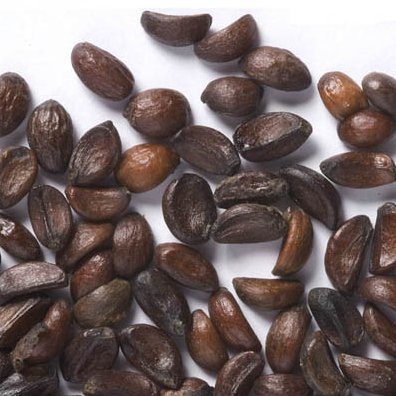

Seed propagation is carried out in spring or autumn, immediately after collecting the seeds. This type of reproduction is quite long: before sowing, the seeds are subject to stratification within 3 months at a temperature of +5 ° C (in the refrigerator).
If seeds are sown in the fall, long before frost, then they will undergo natural stratification. Seeds are sown in grooves to a depth of 1-2 cm.
Another breeding method is possible, which is sometimes advised by experienced Mahonia owners. In winter, several twigs can be placed in jars on a cool, light windowsill.
After a couple of months, roots form on half of them. Try planting them in the spring.According to observations, such plants develop powerful roots, these shrubs grow quickly and have a strong immunity to diseases.
Varieties
Varieties of Mahonia holly:
- The "Gracilis" variety is characterized by long leaves and a thin cut.
- The Apollo variety is characterized by large inflorescences.
- "Jupiter" is a variety characterized by large flowers.
- "Juglandifolia" is a nut-leaved variety.
- "Atropurpurea" variety up to 1 meter high. Decorative flowers, leaves and fruits.
- The “Smaragd” variety grows up to 70 cm in height and 100 cm in width.
Hybrid Mahonia varieties:
- "Winter Sun" variety with yellow and raised inflorescences.
- "Charity" variety with yellow flowers appearing at the end of winter. Growing in our climate zone is problematic, as in the case of the "Winter Sun".
Varieties of creeping Mahonia:
- "Macrocarpa" is a large-fruited variety.
- "Rotundifolia" is a round-leaved variety.
Useful properties of magonia
The Mahonia shrub is popular not only for its decorative qualities, but also because its meyears have useful properties... They include a large number of ascorbic acid, as well as tannins, various alkaloids and organic acids.
The use of fruits strengthens the body's defenses, increases immunity, accelerates blood circulation, strengthens the walls of blood vessels, and improves lymph outflow.
The berries include berberine, therefore, they are recommended to be taken in diabetes mellitus, since the alkaloid increases the activity of insulin. Berberine also helps to restore strength after radiation and chemotherapy.
Not only berries have beneficial properties, but also roots of magonia... Extracts are prepared from them, the use of which is recommended for hepatitis, hepatocholecystitis, gastritis, giardiasis, blockage and inflammation of the biliary tract. The extract has antibacterial and anti-inflammatory properties. Therefore, it is used externally to treat herpes, acne, eczema and to relieve edema. The bark of Mahonia contains substances that help in the treatment of psoriasis.
Features of care in the garden
Care and cultivation of Mahonia holly includes daily watering, feeding, treating the bush from pests, as well as pruning. The plant needs a lot of moisture, gardeners water the near-trunk circle and irrigate the upper branches. This should be done in the evening. Adult shrubs do not need to be watered if the weather is not dry. In hot summer, plants should be irrigated 2 times every 14 days.


Care
Shrubs are fed twice in 12 months: the first in May, and the second in late February. Mineral complexes are used as it. 150 g of fertilizer is required per square meter. When preparing shrubs in the open field for winter, sprinkle the soil with compost or humus. Their layer should be at least 6 cm.
It will not work to take care of Mahonia without a transplant. It is carried out throughout the growing season. The bush should not be transplanted only in the fall. He will not have time to take root and will die with the onset of cold weather. Also, care includes pruning of diseased, dry and frozen branches during the winter. They do it at the end of February. To prevent the bushes from thinning out and staying low, pruning is done in October after the plant stops blooming.
Young bushes are covered with spruce branches before winter. Adult shrubs should be subjected to the same manipulations only if frost is promised. The plant survives peacefully under the snow. Mahonia prefers loose, fertile soil. The best option for her is soil, consisting of humus, sand and turf.
Important! After heavy rain, the soil around the trunk circle is loosened.
Using berries
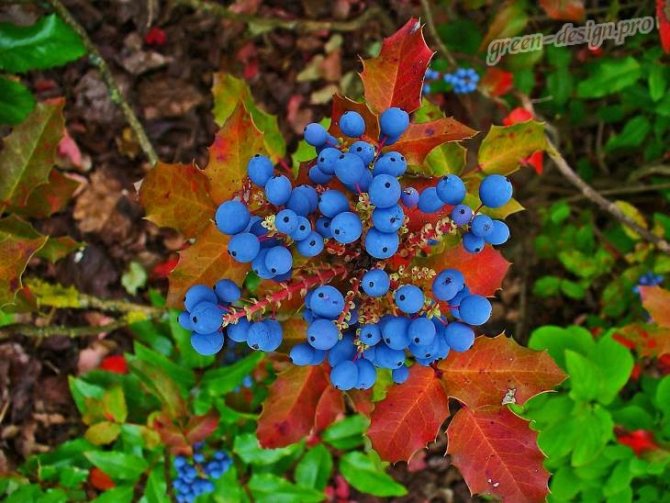

Few know that the bush produces delicious edible berries that are used as a dessert.
The berries of the plant are excellent in the fight against such diseases:
- diarrhea;
- liver diseases;
- rheumatism;
- psoriasis;
- stagnation of bile;
- renal failure.
Also, the fruits are often used to create jelly, jams, wine.
We propagate the plantation
Over time, when you completely fall in love with holly mahonia, its reproduction will become simply necessary - at least to create a beautiful hedge. The number of bushes can be increased in several ways.
- Seeds (unless you cut the flower buds and get the harvest). You can do it right away, barely completing the collection. You can stratify the seed for three months and apply it in early spring (stratification temperature + 5).
- Layers and root suckers. This is the spring method. By the way, by the offspring, the bush itself perfectly spreads over the site.
- The most successful way for your holly mahonia to settle is to propagate by cuttings. For them, young, strong shoots are selected, in which the leaves are fully formed and not damaged. When preparing a cutting, the cut from above should be located as close to the kidney as possible, and from below - at least 2.5, maximum four centimeters from it. The bottom should be treated with growth stimulants. The prepared petiole is placed in a peat substrate. The kidney must be at ground level. After fixing the "seedlings", the substrate is lightly, carefully tamped and spilled with a fungicide - in order to avoid infections.
Summing up, we can say that holly mahonia is an unpretentious, very beautiful and surprisingly useful plant. In addition, it is the only evergreen that easily survives in our conditions.
Contraindications for use
Preparations made from berries, bark or roots of Mahonia are not recommended for people with individual intolerance to the components of the product. Also, their use is contraindicated during pregnancy and lactation, people suffering from intestinal disorders and patients with peptic ulcer disease and increased acidity of gastric juice.In some cases, after taking herbal extracts from Mahonia, side effects in the form of diarrhea or nausea may occur. Before using the beneficial properties of the plant, you need to consult a doctor.
Subject to all the rules for planting and caring for Mahonia holly with the help of a shrub, you can not only decorate your garden, but also get a harvest of useful berries in the fall.
Mahonia holly
Landing rules
To properly plant Mahonia aquifolium, you should adhere to the following simple, but very important recommendations of specialists and experienced florists:
- a shrub needs shade for proper growth and development, and when planted in an open area, it often gets sunburn;
- it is best to allocate windless areas located in partial shade for growing Mahonia;
- Mahonia aquifolium belongs to the category of unpretentious plants and easily adapts to almost any type of soil, including heavy clay soils;
- dense planting assumes the distance between the planted plants of one meter, and with a sparse planting it should be increased to two meters;
- planting pits measuring 40 x 50 cm must be prepared in advance, preferably a couple of months before planting the plants;
- when planting Mahonia aquifolium, it is very important to observe the depth of the seedling immersion, placing the root collar at the same level with the ground;
- immediately after planting, it is necessary to lightly compact the soil and conduct abundant watering.
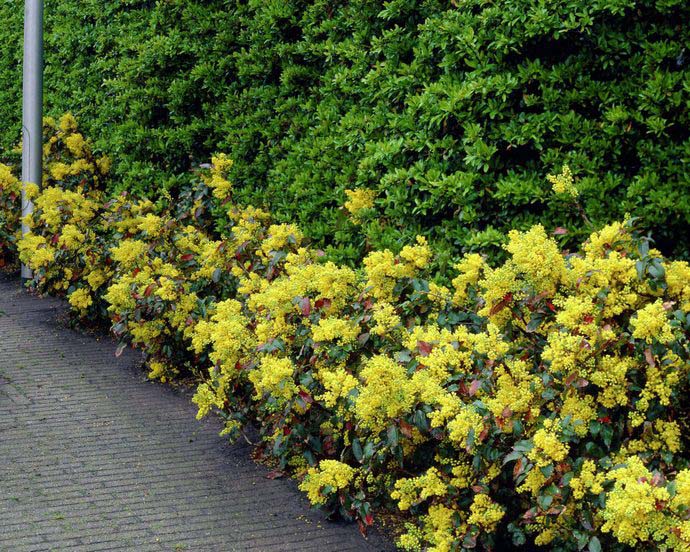

Mahonia aquifolium is very easy to transplant, which can be done at any plant age. The best time for planting and replanting is early spring.
A place


The shrub should be grown in a semi-shaded area in fertile and moist soil. Will grow in a sunny place protected from the wind in a sufficiently damp substrate. Bright sunlight can burn the leaves.To enjoy the good condition of the plant, it is better to plant it in partial shade and on fertile soil. Mahonia Mahonia can act as a groundcover and fill hard spaces in a larger garden.
Benefit for health
And this is not all that the holly mahonia can boast of. The berries, which are very attractive for gastronomic purposes, are not the only tempting plant. Almost all of its parts have their own value:
- the bark contains active compounds that successfully overcome skin diseases, including psoriasis, which was considered invincible;
- an extract is made from the roots, which prevents free radicals, helps with heart, lung and age-related diseases. They also make a therapeutic tonic infusion;
- the leaves, in which the holly mahonia flaunts, are the raw material for antibacterial and antiparasitic drugs.
As you can see, the bush is not only beautiful, but also brings great benefits.
Application in medicine
Back in 2009, the Department of State Control of Medicines decided to assign a registration number to the homeopathic remedy under the trade name substance-tincture of Magonia holly. It is widely used as a certified premium dietary supplement. The bark and rhizomes of Oregon grapes are rich in tannins, acids, vitamin C and alkaloids.
Of particular importance is berberine, which has a strong choleretic and antispasmodic effect.
The substance is prescribed for chronic diseases of the duodenum, liver, stomach ulcer, weakens the manifestations of hepatitis and cholecystitis.
From berries saturated with manganese, zinc, sodium and copper, in folk medicine, decoctions are prepared for such disorders of the digestive system as dysbiosis, constipation and hemorrhoids. Tinctures are effectively used to combat dermatological problems. Liquid products eliminate rashes of various origins, treat psoriasis, vitamin deficiencies, herpes, eczema. The fruit is added to drinks in North America. The juice gives the wines a ruby-red color.
Mahonia has useful tonic and antibacterial properties in the form of medicinal tea, which quickly relieves fatigue, helps against colds and flu.
In addition, regular intake of herbal tincture ensures the recovery of the body after chemotherapy, prevents the development of cancer cells, and enhances the activity of the bone marrow. The tannin in the broth is a strong antioxidant, so Oregon grapes are advised to be used to improve lymphatic blood flow, normalize blood circulation, strengthen the walls of blood vessels and prevent thrombosis.
Dried flower drink helps to overcome gout. Prepared from a teaspoon of dry composition and 1.5 cups of boiling water. After the product has cooled down, strain it. The finished broth is divided into three parts and taken orally in the morning, at lunchtime and in the evening.
Tea is brewed as a supportive therapy for the gastrointestinal tract and cardiovascular system. Pour the crushed roots or bark with a glass of boiling water, bring to a boil in a steam bath. After 15 minutes, cool, filter through a gauze cut and drink.
Alcohol tincture of Mahonia saves from rheumatism, heals liver and kidney diseases, restores metabolism.
If you take 10 grams of dry twigs or the root of a bush, pour 100 grams of vodka and let it brew for a week, after a month you can feel an improvement in the body's work. The daily rate is 5-15 drops.
Contraindications
Not only useful medicinal properties, but also serious contraindications have the plant Mahonia holly.
It is strictly forbidden to use bush-based preparations and homeopathic remedies for pregnant women and women during breastfeeding, people with cholelithiasis, chronic renal and hepatic insufficiency.
Possible individual intolerance to individual components of plant materials and allergic reactions.
Growing and care
When choosing a shrub, attention is paid to the frost resistance of the plant, it is better to abandon dubious ones, and focus on frost-resistant species. These include holly and creeping magonia.
To make the shrub pleasing to the eye, it is planted in a place where there will be suitable climatic and soil conditions. Choose a place that is shady, protected from the wind, characterized by suitable soil, always moist. It is worth planting it in numerous groups of plants near a pond or lake. In such conditions, the shrub will certainly withstand the winter and will not freeze.


In the absence of precipitation in late autumn, watering is required from November in order for the plant to gain the water necessary for wintering. Keep in mind that during the winter, especially when the sun is very hot, the shrub undergoes increased transpiration of water through the leaves. In windy places, transpiration is even higher. In this case, the plant must replenish the loss of water. In cold weather, the shrub cannot get water from the frozen ground, which will lead to wilting of the leaves. If the process is prolonged, the plant will suffer greatly.
The ones recommended for growing Mahonia recover quickly. If the plant is planted in the wrong place, cover it up for the winter.
The root system of the shrub is shallow and not extensive; during prolonged droughts, it is necessary to compensate for the lack of water. The shrub does not like transplanting, before buying and planting a plant, you should think about its permanent place.
Before planting shrubs, you need to remove weeds and enrich the soil with compost. After planting, the plant is watered and mulched.


If necessary, watering is carried out and well-processed compost is applied. As far as pruning is concerned, it is usually not required, only when necessary to restrict growth and remove frozen, damaged shoots.
Mahonia is not attacked by diseases and pests, so there should be no problem growing.
The plant is easy to propagate. Creeping magonia is best propagated through antennae, and holly through seeds that are sown immediately or after stratification in spring, the species is also propagated by cuttings and layering, which is the fastest way to obtain flowering plants. After all, obtaining flowering plants from seeds is possible only after 3-4 years.
Fruits: not only beautiful, but also tasty and healthy
Mahonia holly produces fruits that are somewhat larger than the usual barberry. They have a sweet-sour taste, they give a red juice. Harvested in whole bunches; they are torn off from the stalks only if it is planned to immediately put them into action. Most often, the fruits are used for compotes, juices, wines, preserves and purees. You need to know how useful Mahonia holly is. Its berries, in addition to sugars, contain a huge amount (up to 20 mg) ascorbic acid, pectins, organic acids and P-active substances. And the possibility of long-term storage with simply poured sugar is especially appreciated. Even at the end of the season, the fruits can be eaten fresh.


Photo gallery
What the plant is sick with
Fortunately, Mahonia holly is not affected by most garden pests. There are cases of damage to only two diseases.
- Rust. Signs are found in the spring, when the leaves have climbed out. From below, they clearly show yellow-brown protruding specks, similar to tubercles. If all such leaves are carefully removed, further spread will be stopped. Otherwise, you will have to resort to chemistry, and before flowering begins.
- Powdery mildew. False Mahonia holly does not get sick. The disease looks like a whitish bloom on both sides of the leaf and on the petioles. It affects both flowers and fruits. Salvation is only in chemical preparations.


What are the varieties of Mahonia
Gooseberry Kolobok - the secrets of growing a bush
Mahonia is crossed with plants from the genus barberry. Among the popular decorative forms, the following are distinguished:
- Walnut (f. Juglandifolia). Looks like holly mahonia. The difference is in the foliage. The plant has 7 small leaves on each branch. Leaves are dense with a red petiole.
- Graceful (f. Gracilis). Differs from typical species in longer leaves.
- Golden (f. Aurea). The foliage of such Mahonia has a golden color.
- Variegated (f. Variegata). The leaves contain a patchy color of green and gold.
Additional Information! Caring for the above decorative species is no different from caring for ordinary Mahonia.
When and how to replant seedlings
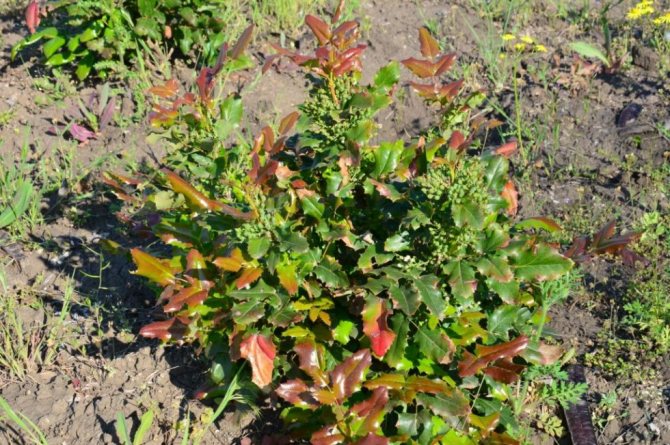

The best time to transplant is early spring.
It is necessary to start the transplant early, eternal. During this period, the plant has not yet entered the stage of sap flow and no serious vegetative processes are taking place in it yet. But you should not be afraid of transplanting when the seedlings managed to bloom, while the foliage is still young. In this growing season, Mahonia will react calmly to changing the place of growth.
It is not recommended to transplant in the fall, especially late. The plant will tolerate this painfully, it may even die.
How to plant a crop correctly:
- Before transplanting, holes must be dug. Their size should be three times the root system of a young bush. The depth of the pit is approximately 50 cm.
- About 1 bucket of humus mixed with earth and sand (in equal shares) is brought into the hole, the bottom is covered with part, the remaining amount will be needed to fill the hole. The plant is inserted horizontally into the well. If there is an earthen lump at the root, they try not to destroy it. An open root system, well melted so that the shoots do not wrap up.
- Sprinkle the bush with earth lightly tamp.
- Water the seedling after planting abundantly and regularly. Overdrying of the soil should not be allowed, earthen covered crusts are undesirable. After watering, the circle around the bush (near-stem) is well covered with humus or any kind of mulch.
The plant will take root quickly if you do not skip watering.
The plant must be planted so that the level of the root collar is the same both before and after transplanting, or 3 cm lower. So after the soil shrinks, the root shoots will not be exposed, and the plant itself will not hurt and weaken from this.
back to menu ↑
See also: Derain: description, types, rules for planting and caring for a plant in the open field, reproduction (75+ Photos & Videos) + Reviews
Shrub in landscaping
Since in our area, Mahonia holly is grown mainly for beauty, let us dwell on the features of its use in this regard. Its "seductiveness" is enhanced by the fact that it successfully resists smoke and gas pollution. Not only does it not wither itself, it also cleans the air. In cities and near roads, this is very important.
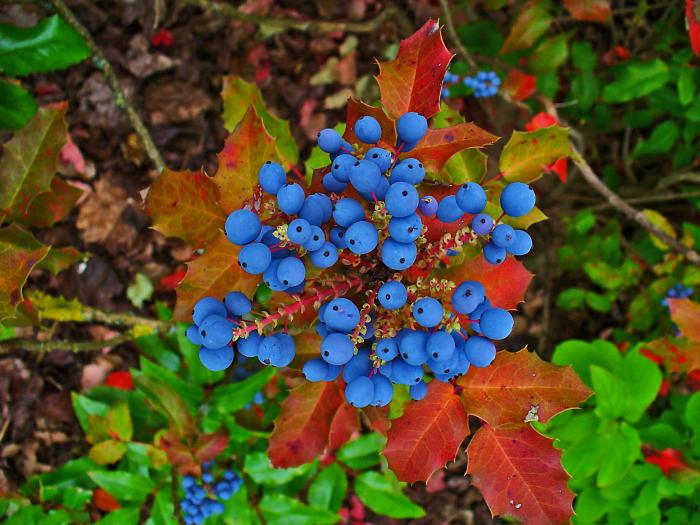

Mahonia holly is used to "pad" trees with a bare trunk and taller bushes, the bottom of which does not look very attractive. Very good in group plantings, hedges and rockeries. In cut, it revives and makes original bouquets and wreaths.
The most recommended in compositions with Mahonia are Japanese quince, thuja, felt cherry, juniper, rhododendrons and low heather plants. Flowers - chrysanthemums, roses, dicentra bushes. However, it looks great with other garden and ornamental bushes and trees.
Possible growing problems
Mahonia is resistant to pests and various diseases. However, with improper care, traces of rust, powdery mildew, and spotting are noticeable on the plant.Below is a list of diseases, as well as recommendations for their treatment.
- Spotting. It manifests itself in the form of crimson spots of various sizes located on the leaves of the plant. They can form if the plant is planted in an area with polluted air and due to lack of nutrients. Treat the spot by spraying with products containing copper or polycarbacin.
- Powdery mildew. It is a fungal disease that affects the leaves and fruits of the shrub. It looks like a white mottled bloom. The bush is treated in the summer, once every 2 weeks by spraying it with topsin-M or caratan. As a preventive measure, shrubs are fertilized with mixtures, which include a large amount of potassium and phosphorus.
- Rust. The disease is caused by a rust fungus. It looks like orange spots on the leaves. Soon, these pustules crumble. When you touch them, rusty sand remains on your hands - mushroom spores. Rust reduces frost resistance, worsens productivity. Its development is facilitated by an excess of nitrogen fertilizers. Cynab and sulfur-containing products help get rid of rust.
- Phylostictosis. This disease is a spreading infection. The affected areas turn brown or brown. Leaves die off over time, and the intensity of flowering worsens. The disease is spread by wind and raindrops. The fungus gradually begins to penetrate the stem as well as the root system of the plant. To get rid of it, you must first remove the affected and fallen leaves, and then treat the bush with a fungicide.
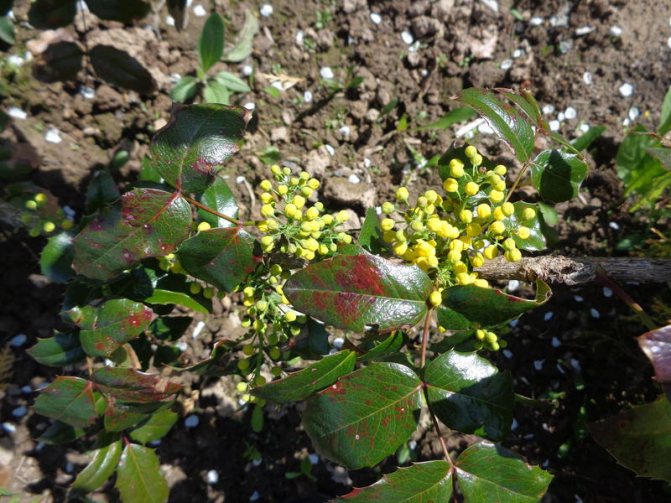

Disease
The main indicators that the gardener does not properly care for the bush are the formation of spots, as well as other lesions, excessive falling of fruits, leaves and buds. If the plant begins to wither, then it must be transplanted to a new place, cut off all damaged areas, water, and then add fertilizers to the soil. If necessary, the bush is sprayed with a "medicinal" agent.
Among pests, Mahonia, like barberry, attracts the attention of the following individuals:
- Aphid. It is a small yellow or red insect that lives under the leaves of the plant. Aphids slowly eat the bush. "Aliot" or "Kinmiks" will not help to get rid of. Also, the product is made independently by mixing a spoonful of tobacco, soap and 200 ml of water.
- Sawfly. It looks like a caterpillar with a black head and sixteen legs. The insect feeds on shoots and foliage. The drug "DNOC" will help to get rid of it.
- Fruit moth. This insect eats the fruits of Mahonia and other trees in the garden. It is a gray-brown moth larva that leaves its offspring inside foliage or fruit. The hatched insects begin to rapidly eat the plant. Get rid of it with insecticides.
In order for all funds to work as efficiently as possible, all affected leaves are cut and burned before spraying. Water the bush before buds appear.
Important! The procedure is repeated without fail after 20 days.
The varieties most popular with gardeners
Rose Pomponella (Pomponella) - characteristics of varietal shrub
The varieties presented below are winter-hardy and unpretentious in care, which attracts the attention of gardeners.
- Magonia Apollo (Apollo). The bush grows from 50 to 100 cm. Leaves 25 cm long have a jagged edge and consist of 7 leaf plates. They are green in summer and brown in autumn. The flowers are colored lemon. The dark blue berries contain a waxy coating on the skin.
- Magonia atropurpurea (Autropurpurea). The height of the bush reaches 65 cm. The leaves are dark green. They do not exceed 30 cm in length. The flowers are bright yellow.
- Magonia Smaragd. A distinctive feature is the shiny emerald-colored leaves with a clear pattern of veins.

